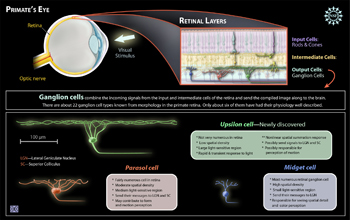All Images
News Release 07-156
New Type of Retinal Cell Discovered in Primates
This material is available primarily for archival purposes. Telephone numbers or other contact information may be out of date; please see current contact information at media contacts.

The eye's retina is composed of three layers of cells. Rods and cones are in the input cell layer. They sense light and convert this information into electrical signals that they send along to the intermediate cell layer. Those cells then transfer the signals to the output cells or "retinal ganglion cells." There are about 22 ganglion cell types known in the primate retina but only about six of them have been well-described physiologically. Recently researchers have been able to describe the electrophysiology of the upsilon cell. The renderings shown here are an artist's conception. No micrographs of these cells have been taken yet.
Credit: National Science Foundation
Download the high-resolution JPG version of the image. (957 KB)
Use your mouse to right-click (Mac users may need to Ctrl-click) the link above and choose the option that will save the file or target to your computer.

A pinhead size 512-electrode array in the center of this "neuroboard" records the output of retinal neurons.
Credit: Photo by Rachel Kalmar and Alan Litke
Download the high-resolution JPG version of the image. (122 KB)
Use your mouse to right-click (Mac users may need to Ctrl-click) the link above and choose the option that will save the file or target to your computer.


